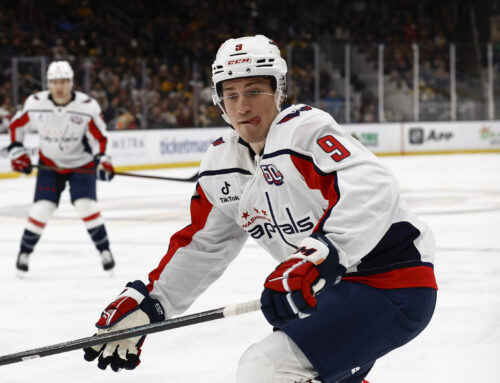In this week's Eastern Edge, we'll check on a few skaters in their first season with a new team. The idea was inspired by Grant Campbell, who took a more extensive look at a similar topic in the Western Conference this week.
The 37-year-old defenseman is doing well in his first year with the Hurricanes, posting 20 points in 27 appearances, which translates to 61 points over 82 games. Burns was a notorious high-volume shooter in his prime but averaged a more modest 2.5 shots per game over his last two years in San Jose. He's turned back the clock this year, posting 3.4 shots per game. The improved shot rate is partially explained by a change in deployment. During his final years with the Sharks, he started 40% of his shifts in the offensive zone and 60% of his shifts in the defensive zone. Those proportions have flipped this year, as Burns is now starting more shifts in an attacking position.
Although his overall ice time is about two and a half minutes lower than it was during his final seasons with the Sharks, he's maintained a similar role with the man advantage, enjoying a 63% share of Carolina's total power-play time. That's been important as almost half of his points have come with the man advantage. After scoring 0.22 power-play points per game last season, he has 0.33 per game so far this year. At first, I thought Burns was scoring more with the man advantage because his new team is better on the power play than his old team was, but that isn't really the case. The Hurricanes' current success rate of 17.2% is actually a step below the Sharks' 19% success rate from last season. Rather, it seems like Burns is benefitting from a greater volume of power-play time thanks to his new team drawing more penalties. Carolina is averaging 3.44 power-play opportunities per game so far this season, while San Jose saw 2.63 per game last year. That extra opportunity has resulted in Burns averaging 3:36 of power-play time per game this year – up from last year's average of 2:39. Based on what we've seen in recent years, it's rare for a team to average three and a half power plays per game for 82 games. As a result, it's likely that Carolina sees a small reduction in their opportunities per game as the season progresses, but not so much that it would significantly affect Burns' power-play production.
The 27-year-old winger arrived in Detroit with three seasons of NHL experience, all of which came with the Blackhawks. He burst onto the scene with 30 goals in 68 games as a rookie during the 2019-2020 campaign. Although he didn't score as many goals during his sophomore season, he matched the 55-point pace he posted in year one. His third and final season in Chicago was his least productive as he managed an underwhelming 33-point pace. Although Kubalik's offensive potential was evident during his time with the Blackhawks, he was never really given a prime opportunity to show off his talent. Fortunately, the Red Wings have given him more room to succeed this year. Kubalik is skating 16 and a half minutes a night this season – a two-minute increase from his average ice time last year. More importantly, he's enjoying a 63% share of Detroit's total power-play time, a massive jump from the 33% share he held in Chicago last season. The extra opportunity with the man advantage has paid off as Kubalik has 12 power-play points through 27 games. That power-play success is a big reason why he's currently scoring at a career-high 76-point pace.
Although I'm optimistic about Kubalik's fantasy outlook this year, it's worth noting that the bulk of his offense came early in the season as he tallied 10 points in his first six games. Since then, he's posted 15 points in 21 games which translates to about a 60-point pace. I think that's more of what we should expect going forward – a 60- to 65-point pace.
Heading into the season, many were wary that DeAngelo's defensive deficiencies would land him in coach John Tortorella's doghouse. Those concerns were pushed to the side early on as he opened the 2022-2023 campaign with five points in his first four appearances. Remarkably, three of those points came with the man advantage and it looked like DeAngelo was breathing new life into a Flyers' power-play that finished with a league-worst 12.6% success rate last year.
Unfortunately for those who roster DeAngelo in fantasy leagues, that early optimism was short lived. Since that hot start, DeAngelo has managed just nine points in his last 22 appearances. He's remained productive on the man advantage, as five of those nine points have come on the power-play. Despite the production, I don't think DeAngelo has made the Flyers' power-play much more dangerous than last year. The team currently sits 28th in the league with a 16.3% conversion rate. He's been able to put up points thanks to a high volume of opportunity, seeing 67% of the team's time with the man advantage, which has worked out to 3:40 per game so far. Speaking of opportunity, DeAngelo is averaging a career-high 24 minutes and 18 seconds of action per game. That represents a four-and-a-half-minute increase from last year. Although he had been seeing more ice time this season, he hasn't been seeing any ice time recently, listed as a healthy scratch for Philadelphia's last two games. It sounds like DeAngelo has been dealing with a nagging foot injury, and the coaching staff noticed his play fall off recently when he was trusted with more minutes. As a result, they felt it was best to take him out of the lineup for now. From my perspective, DeAngelo's defensive struggles make him too risky to roster in most fantasy leagues. Although he's seen a high volume of opportunity this season, he hasn't done enough to ensure he holds onto such opportunity over the course of the campaign.





 EDM
EDM DAL
DAL S.J
S.J MTL
MTL TOR
TOR VAN
VAN CAR
CAR UTA
UTA NYI
NYI CGY
CGY L.A
L.A
